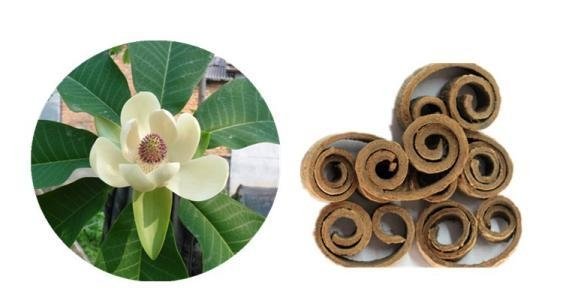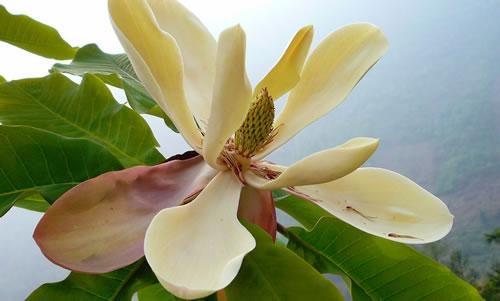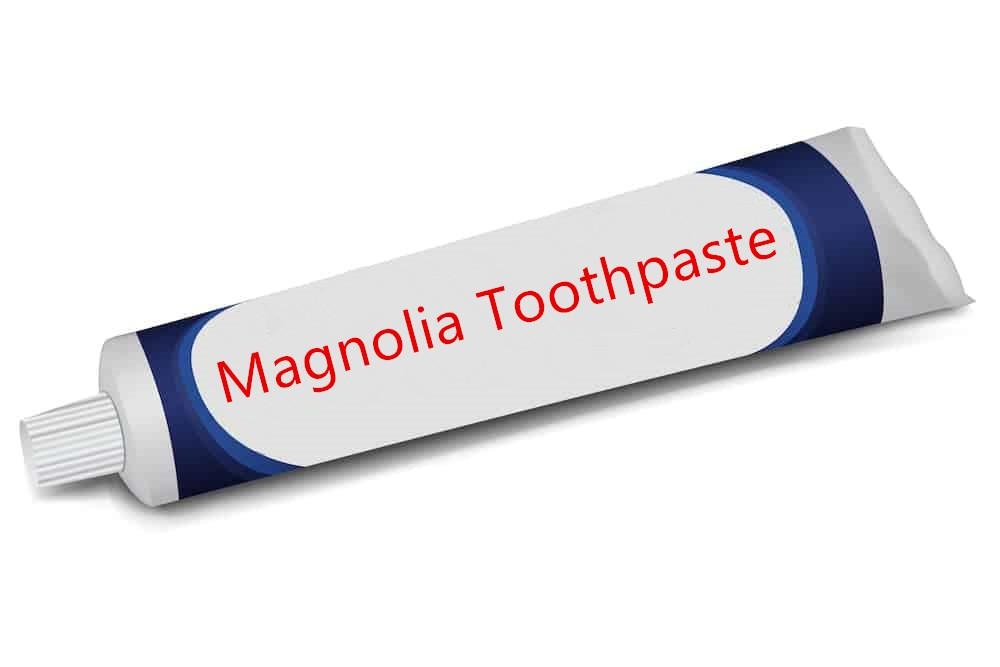
厚朴提取物
來源: 厚朴
拉丁名稱:Magnolia officinalis.
提取部位: 為木蘭科落葉喬木植物厚朴Magnolia officinalis Rehd.et Wils.或凹葉厚朴M.officinalis Rehd.et Wils. var.biloba Rehd.et Wils.的干皮、根皮及枝皮
規格: 1%-98%
有效成份 :厚朴酚,和厚朴酚,厚朴總酚
CAS:magnolol:528-43-8,honokiol:35354-74-6,
magnolol+honokiol:1445684-99-0
檢測方式:HPLC
顏色: 淺黃色至類白色
厚朴,為木蘭科植物厚朴和廬山厚朴的樹皮、根皮和枝皮。厚朴提取物的主要成分有厚朴酚、和厚朴酚,厚朴油揮發油的主要成分為桉葉油醇,厚朴提取物中的生物碱有厚朴碱。目前主要提取的有效成分有,厚朴總酚,厚朴酚和和厚朴酚,同時厚朴也常用在化妝品中作為廣譜抗菌素,抗菌美白和天然防腐劑。

厚朴提取物的應用
醫藥

日化用品

護膚品

厚朴提取物的含量測定
【含量測定】照高效液相色譜法測定。

參考文獻:
1.Bae K, Yoo B, Lee M, Seo W (1985) Antimicrobial activities of hydroxybiphenyl derivatives. I. Antibacterial activities and HPLC determination of magnolol and honokiol. Arch. Pharm. Res. 8: 85–89
2.Clark A M, El-Feraly F S, Li, W (1981) Antimicrobial activity of phenolic constituents of Magnolia grandiflora L. J. Pharm. Sci. 70: 951–9523.
El-Feraly F S, Li W (1978) Phenolic constituents ofMagnolia grandiflora L. seeds. Lloydia 41: 442–449
3.Fujita M, Itokawa H, Sashida Y (1972) Honokiol, a new phenolic compound isolated from the bark of Magnolia obovata Thunb. Chem. Pharm. Bull. 20: 212–213
4.Fujita M, Itokawa H, Sashida Y (1973a) Studies on the components of Magnolia obovata Thunb. I. On the components of the essential oil of the bark. Yakugaku Zasshi 93: 415–421
5.Fujita M, Itokawa H, Sashida Y (1973b) Studies on the components of Magnolia obovata Thunb. II. On the components of the methanol extract of the bark. Yakugaku Zasshi 93: 422–428
6.Fujita M, Itokawa H, Sashida Y (1973c) Studies on the components of Magnolia obovata Thunb. III. Occurrence of magnolol and honokiol inM. obovata and other allied plants. Yakugaku Zasshi 93: 429–434
7.Fukuyama Y, Otoshi Y, Miyoshi K, Nakamura K, Kodama M, Nagasawa M, Hasegawa T, Okazaki H, Sugawara M (1992) Neurotrophic sesquiterpene-neolignans fromMagnolia obovata: Structure and neurotrophic activity. Tetrahedron 48: 377–392
8.Ito K, Tida T, Ichino K, Tsunezuka M, Hattori M, Namba T (1982) Obovatol and obovatal, novel biphenyl ether lignans from the leaves ofMagnolia obovata Thunb. Chem. Pharm. Bull. 30: 3347–3353
9.Mori M, Aoyama M, Doi S, Kanetoshi A, Hayashi T (1997) Antifungal activity of bark extracts of deciduous trees. Holz Roh-Werkst. in press
10.Namba T, Tsunezuka M, Bae K, Hattori M (1981) Studies on dental caries prevention by traditional Chinese medicines. I. Screening of crude drugs for antibacterial action againstStreptococcus mutans. Shoyakugaku Zasshi 35: 295–302
11.Namba T, Tsunezuka M, Hattori M (1982a) Dental caries prevention by traditional Chinese medicines. II. Potent antibacterial action of Magnoliae cortex extracts againstStreptococcus mutans. Planta Med. 44: 100–106
12.Namba T, Hattori M, Tsunezuka M, Yamagishi T, Konishi K (1982b) Studies on dental caries prevention by traditional Chinese medicines. III. In vitro susceptibility of a variety of bacteria to magnolol and honokiol, the components of Magnoliae cortex. Shoyakugaku Zasshi 36: 222–227
13.Rudman P (1965) The cause of natural durability in timber. XVII. The causes of decay and termite resistance inCallitris columellaris F. Muell. Holzforschung 19: 52–57
14.Watanabe H, Watanabe K, Hagino K (1983a) Chemostructural requirement for centrally acting muscle relaxant effect of magnolol and honokiol, neolignan derivatives. J. Pharm. Dyn. 6: 184–190
15.Watanabe K, Watanabe H, Goto Y, Yamaguchi M, Yamamoto N, Hagino K (1983b) Pharmacological properties of magnolol and honokiol extracted fromMagnolia officinalis: Central depressant effects. Planta Med. 49: 103–106
16.Watanabe K, Watanabe H, Goto Y, Yamamoto N, Yoshizaki M (1975) Studies on the active principles of Magnolia bark. Centrally acting muscle relaxant activity of magnolol and honokiol. Jpn. J. Pharmacol. 25: 605–607
17.Antifungal constituents in the bark ofMagnolia obovata Thunb
The acetone extract of the bark ofMagnolia obovata...Thunb. had potent antifungal activity against plant pathogenic and wood destroying fungi. The active principles were isolated and identified to be eudesmols (I...
M. Mori, M. Aoyama, S. Doi in Holz als Roh- und Werkstoff (1997)
18.Anti-Helicobacter pylori effect of costunolide isolated from the stem bark ofMagnolia sieboldii
Helicobacter pylori (H. pylori) infection is now established as the major pathogenic factor in chronic gastritis and peptic ulcer disease. In addition, there is accumulating evidence that
Jong-Beak Park, Chong-Kyo Lee, Hee Juhn Park in Archives of Pharmacal Research (1997)
19.Separation and determination of magnolol and honokiol inMagnolia officinalis bark by capillary zone electrophoresis
The effects of pH on separation parameters such as migration mobility, resolution, sensitivity, column efficiency and peak shape were emphatically studied. Better separation of magnolol and honokiol using capi...
Ziping Zhang, Zhide Hu, Gengliang Yang in Microchimica Acta (1997)
20.Cytotoxic germacranolide sesquiterpenes from the bark of Magnolia kobus
A new (3...) and three known germacrane-type sesquiterpenoids were isolated from the chloroform-soluble fraction of the methanolic extract of the bark of Magnolia kobus (Magnoliaceae) through repeated silica gel ...
Hee Wook Park, Jae Hyeok Lee, Sang-Un Choi, Nam-In Baek… in Archives of Pharmacal Research (2010)
21.Effects of (+)-eudesmin from the stem bark of Magnolia kobus DC. var.borealis Sarg. on neurite outgrowth in PC12 cells
(+)-Eudesmin [4,8-bis (3,4-dimethoxyphenyl)-3,7-dioxabicyclo[3.3.0]octane] was isolated from the stem bark ofMagnolia kobus DC. var.borealis Sarg. and found to have neuritogenic activity. 50 μM (+)-eudesmin induc...
Yoo Jung Yang, Jae In Park, Hak-Ju Lee, Seon-Mi Seo… in Archives of Pharmacal Research (2006)
22.Furofuran lignans from the bark of Magnolia kobus
A new furofuran lignan (1) along with four knownones (2-5) were isolated from the bark of Magnolia kobus. Their structures were elucidated as (+)-2α-(3’,4’-dimethoxyphenyl)-6α-(3″-hydroxy-4″,5″-dimethoxyphenyl)-3...
Seon-Mi Seo, Hak-Ju Lee, Oh-Kyu Lee, Hyun-Jin Jo… in Chemistry of Natural Compounds (2008)
23.Apoptosis-inducing Costunolide and a novel acyclic monoterpene from the stem bark ofMagnolia sieboldii
In a course of obtaining more amount of bioactive costunolide and successive phytochemical isolation fromMagnolia sieboldii (Magnoliaceae), a novel acyclic monoterpene 1 named deoxygeraniol (2,6(E)-dimethyl-2, 6-...
Hee Juhn Park, Sang Hyuk Kwon, Yong Nam Han… in Archives of Pharmacal Research (2001)
24.Biological activity and toxicity of the Chinese herb Magnolia officinalis Rehder & E. Wilson (Houpo) and its constituents
Traditional Chinese herbal drugs have been used for thousands of years in Chinese pharmacopoeia. The bark of Magnolia officinalis Rehder & E. Wilson, known under the pinyin name “Houpo”, has been traditionally us...
Mélanie Poivre, Pierre Duez in Journal of Zhejiang University-SCIENCE B (2017)
25.Magnolia Ethanol Extract on Growth of Tumor in Tumor Mice S180
This paper carries on anti-tumor activities research of the ethanol extract of Magnolia officinalis (MEE). Our results showed that MEE has obvious anti-tumor activities to transplanted tumor model of the mouse...
Lin Yuan, Xianju Huang, Jiaqiang Sun in Information Technology and Agricultural Engineering (2012)
26.Effect of a proprietary Magnolia and Phellodendronextract on stress levels in healthy women: a pilot, double-blind, placebo-controlled clinical trial
Recent research has established correlations between stress, anxiety, insomnia and excess body weight and these correlations have significant implications for health. This study measured the effects of a propr...
Douglas S Kalman, Samantha Feldman, Robert Feldman, Howard I Schwartz… in Nutrition Journal (2008)
27.Protective effect of the ethanol extract of Magnolia officinalis and 4-O-methylhonokiol on scopolamine-induced memory impairment and the inhibition of acetylcholinesterase activity
Magnolol, honokiol, and obovatol are well-known bioactive constituents of the bark of Magnolia officinalis and have been used as traditional Chinese medicines for the treatment of neurosis, anxiety, and stroke. W...
Yong Kyung Lee, Dong Yeon Yuk, Tae Il Kim, Young Heui Kim… in Journal of Natural Medicines (2009)
28.This index lists all 3367 normalized pharmacological activity terms appeared in the encyclopedia in alphabetical order and a number code sequence of the related compounds follows the bold term immediately.
Jiaju Zhou, Guirong Xie, Xinjian Yan in Encyclopedia of Traditional Chinese Medici… (2011)
29.Anti-platelet effect of the constituents isolated from the barks and fruits ofMagnolia obovata
In the course of our work on anti-platelet constituents from plants, five phenolic compounds, mag-nolol, honokiol, obovatol, methyl caffeate, and syringin, were isolated from the methanol extracts of the barks an...
Mi Kyung Pyo, YongYook Lee, Hye Sook Yun-Choi in Archives of Pharmacal Research (2002)
30.Antioxidant activity of the different polar solvent extracts of Magnolia officinalis leaves and purification of main active compounds
The leaf of Magnolia officinalis is abundant in natural resources as a novel potential antioxidant and has great commercial value. In this study, the contents of total phenolics, total flavonoids, magnolol and ho...
Li-Hong Tan, Dan Zhang, Bao Yu, Sheng-Ping Zhao… in European Food Research and Technology (2015)
31.Magnolia grandiflora
Tong Kwee Lim in Edible Medicinal and Non Medicinal Plants (2014)
32.Effects of aging on the phenolic content and antioxidant activities of magnolia (Magnolia denudata) flower extracts
Magnolia contains a large variety of physiologically active compounds, including phenolic compounds, and the magnolia flower is used for preparation of tea. The phenolic content and antioxidant activities of m...
Hyungeun Yoon in Food Science and Biotechnology (2014)
33.Effect of Magnolia officinalis and Phellodendron amurense (Relora®) on cortisol and psychological mood state in moderately stressed subjects
These results indicate that daily supplementation with a combination of Magnolia bark extract and Phellodendron bark extract (Relora®) reduces cortisol exposure and perceived daily stress, while improving a varie...
Shawn M Talbott, Julie A Talbott, Mike Pugh in Journal of the International Society of Sp… (2013)
34.Magnolia spp.
There are three official entries containing Magnolia species in the Chinese Pharmacopoeia:
Xinyi, Flos Magnoliae, is the dry flower buds of Magnolia biondii Pamp., M. denudata Desr...
Professor Dr. Weici Tang, Professor Dr. Gerhard Eisenbrand in Chinese Drugs of Plant Origin (1992)
35.Magnolia grandiflora Linn.
C.P. Khare in Indian Medicinal Plants (2007)